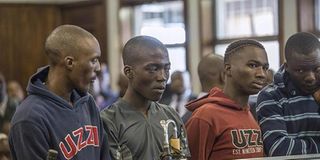South Africa army to tackle attacks on foreigners

Suspected killers of Emmanuel Sithole, a Mozambican, at the Wynberg Magistrate Court in Johannesburg on April 21, 2015. PHOTO | MUJAHID SAFODIEN |
What you need to know:
- Troops are being sent to volatile areas in Johannesburg and KwaZulu Natal province.
JOHANNESBURG
South African soldiers will be deployed to tackle gangs hunting down and killing foreigners, officials said on Tuesday, after at least seven people died in a wave of anti-immigrant violence.
Police in the economic capital Johannesburg and in the port city of Durban have struggled to contain mobs who have targeted migrants from Zimbabwe, Malawi, Mozambique and other African countries over the last three weeks.
The government had vowed to crack down on the unrest, but the decision to put soldiers on the streets came after two nights of relative quiet in both cities.
“We come in as the last resort — the army will serve as a deterrent,” Defence Minister Nosiviwe Mapisa-Nqakula told reporters, declining to give details on how many troops would be involved.
“There are people who will be critical, but those who are vulnerable will appreciate this decision,” she said.
“Now we are deploying soldiers because there is an emergency.”
The spate of attacks has revived memories of xenophobic bloodshed in 2008, when 62 people were killed in Johannesburg’s townships, rattling South Africa’s post-apartheid image as a “rainbow nation” of different ethnic and cultural groups living in harmony.
The South African army was deployed to restore order in the 2008 unrest, and has also been used against violent strikers in 2012 and 2014.
Mapisa-Nqakula said troops were being sent to volatile areas in Johannesburg, and also to KwaZulu Natal province, of which Durban is the capital.
In Johannesburg, the military presence will focus on the township of Alexandra, a poor neighbourhood recently roiled by xenophobic clashes, including a Mozambican man stabbed to death in broad daylight on Saturday.
Graphic photographs of the killing were published by many South African and international newspapers and websites.





